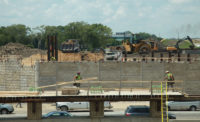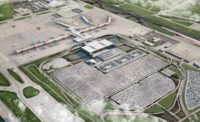Work is just starting to ramp up on EOWA, but I-90's $2.5-billion expansion is well under way. "The I-90 corridor is 55 years old," says Kovacs. "We were going to have spent a couple hundred million dollars a year just to keep it patched up." The 37-mile western segment is expected to complete this year; the 25-mile eastern segment is slated for a 2016 completion.
"We are building a lot of smart corridor features," says Lafleur. Gantries at half-mile increments will provide real-time incident information and a future inside shoulder can serve as a dedicated bus lane or as an extra vehicle lane. Lafleur says the "smart" corridor could add 20% more capacity.
Partnering with a transit agency on that future bus lane is just one example of extensive community partnering, officials say. Lacking design-build authority, the tollway reached out to environmental stakeholders very early on. "Up front, we went to conservancies, commissions, wildlife foundations ... and we asked about long-range plans," says Rocco Zucchero, tollway deputy chief engineer.
The tollway consequently offered to incorporate desired wetlands projects, such as bike trails, as part of its mitigation process, he adds.
"The tollway is not operating in a vacuum," says Kovacs. "We're delivering projects identified by stakeholders as having the most significance for the region. We're fitting into the larger scheme of things, rather than only worrying about ourselves."





Post a comment to this article
Report Abusive Comment